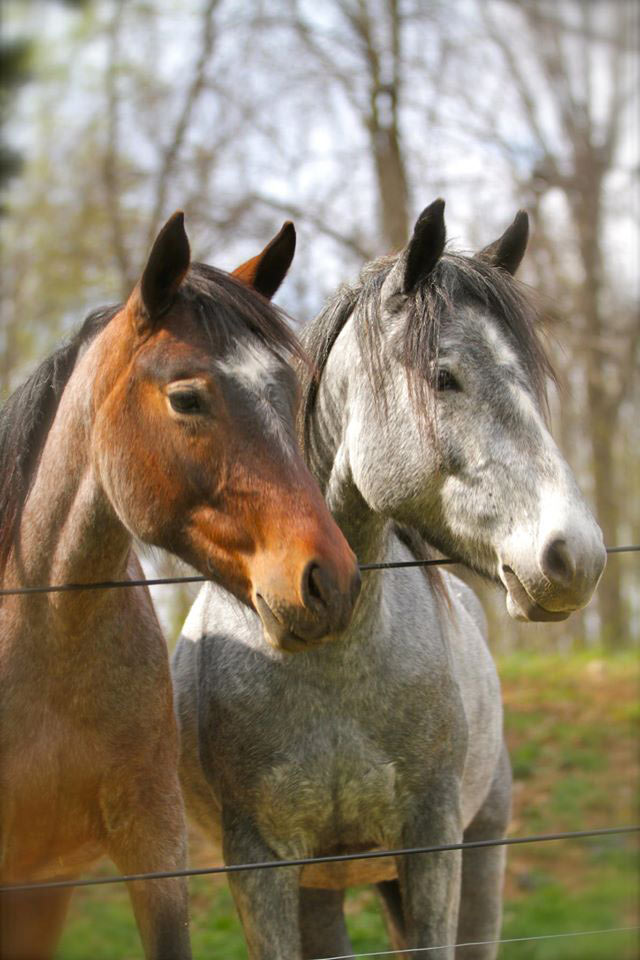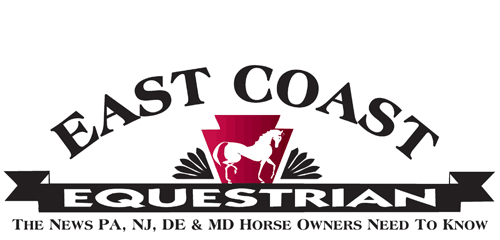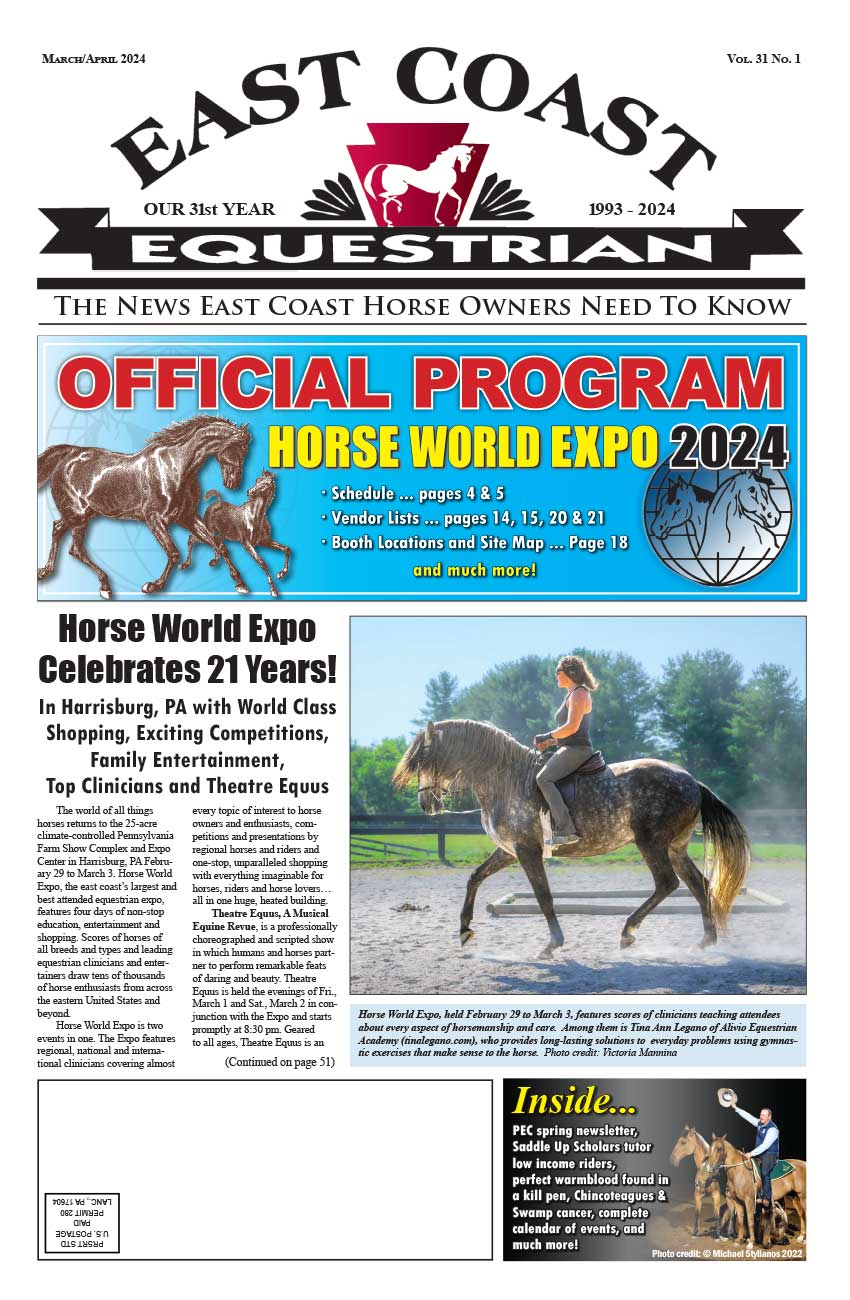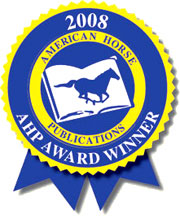 Kachina, left, and Moon were the first two Nokota horses to arrive at Flowing Springs Farm in Chester County, PA.
Kachina, left, and Moon were the first two Nokota horses to arrive at Flowing Springs Farm in Chester County, PA.
Low rumbles of thunder growled across the pasture, but a silvery-blue roan paid them no heed. He stood steadfast in the sheeting rain, his left hind cocked calmly as he ignored the three-sided shed built for his comfort. He is a hardy, rugged type, straight from the badlands of southwestern North Dakota. His name is Hunkpapa, and he is one of the seven feral Nokota horses at Flowing Springs Farm in Chester Springs, PA.
Christine McGowan runs the Nokota Horse Preserve and the Preserve Learning Center out of her 14-acre farm along with close friend and professional counselor, Kendra Prescott. McGowan started her career as a traditional English rider but without the means necessary to purchase her own horse at a young age. Instead, she made herself invaluable to the horse people around her and soaked up as much knowledge as she could. Finally, at age 40, she bought her first horse—an off-track Thoroughbred mare that scared her half to death.
However, when McGowan later moved to Flowing Springs Farm, she had a life-changing experience. A neighbor was riding down the lane on a breezy September morning, leading a toddler on another pony. McGowan was floored—“What are you on,” she had asked, “that you trust so much?” The answer was a Nokota.
The Nokota Horse is considered an ultimate in survival—DNA testing has traced the bands back to the lost horses bred by the Native American Hunkpapa Lakota chief Sitting Bull. Primarily remembered as the great warrior who contributed to the defeat of Lieutenant Colonel Custer at the Battle of Little Bighorn, Sitting Bull was mainly a peacemaker and avid horseman.
Horses were the center of Lakota life and Sitting Bull carefully bred for the characteristics he valued for these equine companions—kind and calm temperaments to carry the tribe’s revered elderly, the pregnant, and the children, hardy and athletic conformations to carry the warriors into battle, and most importantly, brilliant and curious minds that wanted to bond with human beings. The Lakota treasured the Nokota Horse so much, they would tie leather thongs from their wrists to their horses’ ankles as they slept in their tents, so the Nokota would wake their partners in the event of an attack.
When the Lakotas were forced from their lands, the Nokota Horse remained. They roamed wild in an untapped band throughout the rugged Little Missouri Badlands until being inadvertently fenced in within the Theodore Roosevelt National Park during the 1940s. Treated as unwanted vermin, the herds were hunted and shot or sold at auctions as park officials tried to remove the “pest” that was the Nokota Horse.
In the late 1970s, horsemen Leo and Frank Kuntz were on a mission to build a better cross-country racehorse and were going to auctions searching for something to breed into Thoroughbred blood. They were looking for better hooves, stronger bone, more resilient legs…and started recognizing a similarity in the horses they were choosing. The Nokota Horse has tough hooves, a square shoulder, a thick body, and a sloping hindquarter that cuts sharply down towards the tail. The Kuntz brothers were convinced (correctly) that these agile creatures were a piece of living history, and they bought as many as they could find to preserve the breed. Now the last remaining wild horses in North Dakota, the Kuntz’s Nokota Horse Conservancy farm in Linton, ND manages the herd and brings awareness to the historical breed.
After watching her neighbor on her trusty Nokota Horse on that fateful September morning, Christine McGowan vowed her next horse would be a Nokota. After months of research, she and her husband found themselves in Ohio at a Colt Start, where 10 to 15 two-, three-, and four-year-old feral Nokota Horses are rounded up and hauled to a location for prospective adopters. A couple of professionals help the green handlers with the several-day process of roping, haltering, and bonding with the untouched Nokota Horses.
“It was the most incredible experience,” said McGowan. “These horses are clear and kind. Most of my experiences have been with horses that are more ‘talk to the hoof,’ rather than wanting to connect. These Nokotas are absolutely amazing and truly want to form a relationship with humans.”
At the Colt Start in Ohio, McGowan acquired her first two mares, Moon and Kachina. That was the beginning of a lifelong passion to not only open her home to these endangered creatures, but also create a therapeutic program with the Nokota Horse at its center. “This is my dream come true,” she said. “These horses offer so much back. I’ve seen Nokotas choose their partner, and it’s a beautiful thing to watch. They are so athletic—Moon can jump four foot from a standstill—but also so, so gentle.”
Kendra Prescott, McGowan’s longtime friend, has a background in psychology as well as in horses. Together, they decided to create the Preserve Learning Center at Flowing Springs Farm. “I’ve always felt strongly about helping people,” said Prescott, “but not necessarily in the saddle. So many people are drawn to the spirit and energy of the horse, but it’s not always about riding. Going out and taking a bunch of riding lessons isn’t always the answer.”
Prescott and McGowan discovered an accredited program for equine assisted learning, also known as equine guided learning, called EAGALA (the Equine Assisted Growth and Learning Association) that uses horses as a host for humans to regain self confidence, self esteem, and establish healthy boundaries through body language and equine feedback.
EAGALA certifies mental health professionals to work with clients using the horse as a tool. The EAGALA model always utilizes a two-person team: a mental health specialist and an equine specialist. Prescott is already certified as a mental health specialist through levels one and two as McGowan continues to work on her own equine specialist certification.
An equine assisted learning session would often begin with a client or student going into a group of three or four horses loose in a pasture or ring and then given an activity. Some of the clients have not touched a horse before, and issues immediately surface that clients may need to work though. “The teacher is ultimately the horse,” said Prescott. “They are the facilitators to support processing. All of the interaction is done through the horse, and as we know as horse people, that is very powerful.”
The experiential learning uses the horse to provide heavy metaphor—the interactions with the horse are visible comparisons for whatever may be happening in the client’s life. The students are not told the horses’ names or genders, but instead are asked what they think the horses’ names might be. There are no right or wrong answers, and in such, the horse can then become a pure vessel for whatever the client needs him to be.
“Safety is very important,” said McGowan. “These are feral horses and while they are brilliant and unadulterated at reading body language, they do need to be trained to come off of pressure so they can be handled. All of the horses here are ultimately ridden and have an established schedule, but some are more appropriate for this program compared to others who have been on the farm for less time.”
In addition, the Preserve Learning Center will be hosting a homeschooling camp once a week starting in mid-September, where students ages seven to seventeen will incorporate equine assisted learning with the Nokotas into their academic curriculum to help teach social and emotional learning.
“I think this is a beautiful marriage between the Nokota horse and mental health work. The goal of the Nokota is to form a partnership, and the goal of people is to feel successful and okay,” said McGowan. “While this model is groundwork only, it’s amazing how much the horse offers back in terms of body language. Being feral, there are no issues with them unless we, as humans, have put them there.
“Yes, the Nokotas need our help to keep the breed alive, but I think we can also give them a purpose, so that we need them. I feel very blessed to have these horses on my farm and I’m very excited to see where all of this will lead.”
The pouring rain didn’t seem to bother Hunkpapa one bit as he stood and peered out through his dripping forelock. In fact, he looked more curious about the people running helter-skelter to get out of the rain. What’s the hurry? he seemed to say. That’s the type of Nokota serenity that Christine McGowan plans to build her program around. Helping horses help people.




